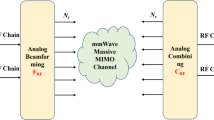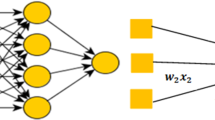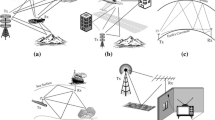Abstract
This paper proposes a multi-input multi-output (MIMO) channel prediction scheme using multi-task learning algorithm. Based on the spatially correlated MIMO channel Channel State Information (CSI) observations, a multi-task least square support vector machine (MTLS-SVM) is trained, where the CSI prediction for each antenna pair can be modeled as one task and jointly learning between these tasks are implemented. Then the future CSI is predicted by this MTLS-SVM. By using the relatedness of the multiple tasks, the spatial correlations between different antenna pairs can fully be exploited and hence better channel prediction performance can be achieved compared with the single task prediction scheme.





Similar content being viewed by others
References
Kulkarni, M. N., Ghosh, A., Andrews, J. G., et al. (2016). A comparison of MIMO techniques in downlink millimeter wave cellular networks with hybrid beamformin. IEEE Transactions on Communications, 64(5), 1952–1967.
Jarinova, D., et al. (2013). On autoregressive model order for long-range prediction of fast fading wireless channel. Telecommunication Systems, 52(3), 1533–1539.
Yan, F. G., Yan, X. W., Shi, J., et al. (2017). MUSIC-like direction of arrival estimation based on virtual array transformation. Signal Processing, 139, 156–164.
Adeogun, R. O., Teal, P. D., Dmochowski, P. A., et al. (2017). Channel prediction for millimeter wave MIMO systems in 3D propagation environments. In International conference on telecommunication (pp. 1–5).
Adeogun, R. O., Teal, P. D., Dmochowski, P. A., et al. (2014). Novel algorithm for prediction of wideband mobile MIMO wireless channels. In IEEE international conference on communiction (pp. 4632–4637).
Bhuyan, M., Sarma, K. K., et al. (2013). Nonlinear model based prediction of time varying SISO-MIMO channels using FANN-DFE combination. 2013 1st International Conference on Emerging Trends and Applications in Computer Science, 143, 104–107.
Kashyap, S., Mollen, C., & Bjornson, E., et al. (2017). Performance analysis of (TDD) massive MIMO with Kalman channel prediction. In IEEE international conference on acoustics, speech and signal processings (pp. 3554-3558).
Adeogun, R. O., Teal, P. D., & Dmochowski, P.A., et al. (2013). Parametric channel prediction for narrowband mobile MIMO systems using spatio-temporal correlation analysis. In Vehicular technology conference (pp. 1–5).
Hjorungnes, A., Akhtar, J., Gesbert, D., et al. (2016). Precoding for space-time block codes in (non-)Kronecker correlated MIMO channels. In IEEE signal processings of conference European (pp. 515–518).
Xu, S., et al. (2014). Multi-task least-squares support vector machines. Multimedia Tools and Applications, 71(2), 699–715.
Kermoal, J. P., et al. (2002). A stochastic MIMO radio channel model with experimental validation. IEEE Journal Selected Areas in Communication, 20(6), 1211–1226.
Xia, R., Liu, Y., et al. (2017). A multi-task learning framework for emotion recognition using 2D continuous space. IEEE Transactions on Affective Computing, 8, 3–14.
Zemen, T., Mecklenbrauker, C. F., Kaltenberger, F., Fleury, B. H., et al. (2007). Minimum-energy band-limited predictor with dynamic subspace selection for time-variant flat-fading channels. IEEE Transactions on Signal Process., 55(9), 4534–4548.
Author information
Authors and Affiliations
Corresponding author
Additional information
Publisher's Note
Springer Nature remains neutral with regard to jurisdictional claims in published maps and institutional affiliations.
Rights and permissions
About this article
Cite this article
Li, J., Sun, D. & Liu, Z. A MIMO Channel Prediction Scheme Based on Multi-Task Learning. Wireless Pers Commun 115, 1869–1880 (2020). https://doi.org/10.1007/s11277-020-07658-8
Published:
Issue Date:
DOI: https://doi.org/10.1007/s11277-020-07658-8




